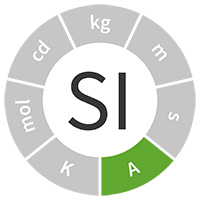 The ampere, or 'amp' for short, measures electric current, which is a flow of electrons along a wire or ions in an electrolyte, as in batteries. Electric current allows us to power electrical devices, like smartphones or laptops and can even be used to operate a bus or car.
The ampere, or 'amp' for short, measures electric current, which is a flow of electrons along a wire or ions in an electrolyte, as in batteries. Electric current allows us to power electrical devices, like smartphones or laptops and can even be used to operate a bus or car.
The ampere has only been in use for as long as we have had access to electricity – a small proportion of the history of measurement. The ampere definition exploits the fact that electric current is made up of a flow of billions of identical charged particles called electrons. We can create a standard ampere by using special nano‑scale electric circuits that control the flow of electrons.
The ampere is defined by taking the fixed numerical value of the elementary charge e to be 1.602 176 634 × 10−19 when expressed in the unit C, which is equal to A s, where the second is defined in terms of ∆ν.
This was a new definition in May 2019.
Electricity (moving electrical charge) is a key way to transport information and energy. Our electricity bills charge us on the basis of how much current we use at what voltage and over what time.
Electrical measurements are found in the readout of almost every type of ‘sensor’ that exists. Accurate measurements support everything from telecommunications and security to automotive and aerospace technologies.
The ampere has previously been defined as the current that would cause the deposition of a certain mass of silver per second from a silver nitrate solution and then in terms of the force created between two infinitely long wires in a vacuum that are carrying the same current.
The ampere may now be realised by controlling the flow of single electrons in a sophisticated semiconductor circuit. In a device under investigation at NPL, electrons are pushed through a narrow channel using tiny oscillating barriers. The current is simply the charge on an electron times the number of electrons transported through the barrier per second.